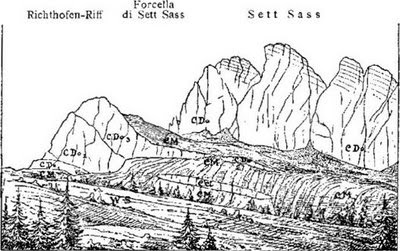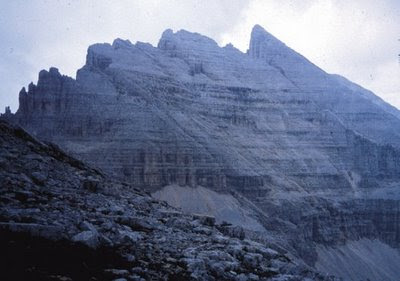Update: Just to clarify, the paper is not out yet. my post is based on the research summary and also a previous paper (open access) on Chicxulub crater cores and also another research summary here.
I find Keller's work and the accompanying debate a great example of how a scientific consensus is being chipped away by a relentless advocate of an alternative theory. Heterodoxy can often be seductive and many people may want Keller to be right simply because she is an underdog. But in this case she has backed up her position with data and testable research questions.
Here's a question.
Did you think that the Chicxulub impact layer is the K-T boundary?
That has been the popular understanding, accepted more so due to a lack of stratigraphic resolution that could separate the two events layers. In localities around the impact zone the sediment within and above the impact layer was thought to have been deposited as tsunami events layers, too short spanned and episodic to faithfully preserve any changes to fauna. The K-T layer above these tsunami deposits is recognized by a marked negative C13 shift in the planktonic foraminifera C13 record. And faunal and floral turnovers above it mark the transition from the Maastrichtian to the Danian. So the stratigraphic record of the impact event has been traditionally seen to be amalgamated with the K-T boundary layer.
update: Why a shift in C13 values? - this is a global signature- normally surface water plankton have positive C13 values since dissolved bicarbonate in sea water is depleted in C12 due to photosynthesis preferentially utilizing the lighter isotope. If organic productivity in surface water decreases due to environmental calamity, more C12 is available in the inorganic reservoir i.e. bicarbonate and skeletons will record a negative shift in C13.
What Keller and colleagues have done is to de-amalgamate the late Maastrichtian stratigraphic record. Their work indicates that the Chicxulub impact occurred a good 300,000 years before the K-T boundary. They show from several localities in Mexico that there is about 4 - 9 meters of sediment above the impact layer that are not tsunami deposits but which have been deposited gradually over a time period of 300,000 years. The K-T boundary lies above this sediment layer. Fauna in this intervening sediment layer i.e the one that lies above the impact layer and below the K-T boundary shows no signs of stress. Species found below the impact layers are found above it too with no noticeable loss of biodiversity. Keller interprets this to mean that the impact did not cause serious environmental stresses and mass extinctions.
Here is a core from a locality in Texas which shows impact event deposits overlain by "normal" sediments which contain geochemical and faunal characteristics of the late Maastrichtian indicating that the impact predated the K-T boundary.

Source: Princeton Geoweb
What I have found impressive about Keller's work is that besides coming up with data against the impact extinction theory, she has also produced evidence to support the alternative hypothesis which is that the Deccan volcanics did most of the damage. Last year I wrote a post summarizing Keller's work on inter-trappean layers- sediments which are sandwiched between Deccan volcanic province lava flows. She showed using a combination of magnetostratigraphy and biostratigraphy that the lava flows encompass the K-T boundary and that sediments above the flow contain post-extinction Danian foraminifera species. The fauna is depauperate and shows signs of stress manifested as deformed tests. So her work draws a direct link between volcanism, environmental stress and faunal turnovers.
Are we ready for a paradigm shift? From this work it looks as if the Chicxulub impact may not have been the causal event that led to a global biotic mass extinction. Was it then only the volcanism?
Hold on ....before we cede everything to the volcanism theory there is still the problem of an iridium anomaly.
The K-T boundary sediments at many locales contain unusually high amounts of iridium interpreted to be of extraterrestrial origin. So what is an iridium anomaly doing 300,000 years after the Chicxulub impact event? Was there a second or in fact a series of impacts in the late Maastrichtian? Or is there a problem with Keller's stratigraphy? Combine that with a global sea-level fall at end Maastrichtian which would have affected shallow marine biota.. and you get the picture. The late Maastrichtian would have been a pretty tough time to live but it could have been that way for a number of reasons. The impact theory is sensational ( all those dinosaurs wiped out by a meteorite) and also simple and maybe we want to believe it.
... this is not over yet.
In the meantime you can follow the Chicxulub debate over here at the Geological society.










